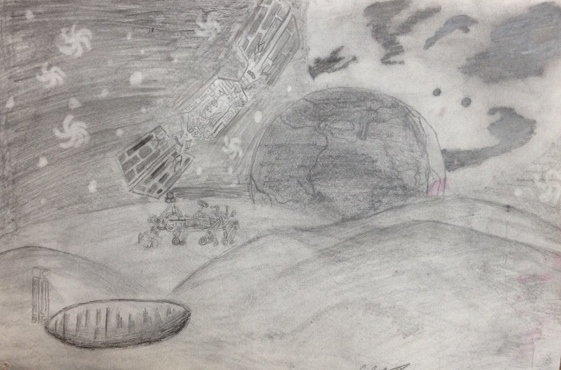Outreach
Winners chosen! Congratulations to 2nd grader Jake Fricke of Alamosa, Colorado and 6th grader Cole Hinkson of Denver, Colorado!
Jake's submission of "H.S. Infinity" won our Name-the-Rover contest. From his essay: “H.S. stands for High Service and I know this robot is engineered for High Service. Infinity means forever. We are going to learn forever and be curious forever. There will never be an era when we know everything. Still, what we do know is big for our world.” Jake has won a visit from the rover for his school and a poster.
Cole submitted a work of art titled "Mining in Space 3-D Universe." From his Artist's Statement: “The things that I see are some very electronic and round shapes. The colors that I see are pencil but slowly shaded in certain parts. In the picture a rover is mining with holes and bunches of mining equipment while a satellite flies by. I like that it has a backdrop of the universe. My inspiration was just my love for astronomy."

Outreach Video
Lakewood High School

Blasterbotica participated in extensive outreach with Lakewood High School pre-engineering students (Figure 4). The program, coordinated by Lakewood Technology teacher Mr. Matthew Brown, sought to connect high school students with real world clients in order to solve engineering issues. Through the program, these students were asked to design, prototype, and test parts for their customers, while the clients provided feedback and guidance on the engineering process. Susan Tran, an alumna of Lakewood High School, volunteered Blasterbotica as a client to mentor a team of these students and provide them with an experience parallel to the Senior Design Capstone course at CSM – and the engineering process implemented in industry. Through the involvement of Blasterbotica, the Lakewood students received an introduction to the engineering cycle while working with a real client to solve a real problem. Through the school year, they moved through the cycle, starting with brainstorming, design, prototyping, testing, and finally revising and retesting their design.
In October 2013, the Lakewood student team, known as The Colonels, were asked to redesign the buckets for the bucket ladder with the goal of increasing both collection capability and durability while remaining within specified restrictions. These restrictions included creating buckets that could work with the geometry of the existing chassis and bucket ladder, remain light-weight enough to avoid damage to the bucket ladder conveyor belt, and withstand the abrasive nature of BP-1.
In November, Blasterbotica met again with The Colonels to review their initial design proposals. During this meeting, Blasterbotica examined the initial bucket designs and offered feedback, in addition to teaching the students some of the challenges associated with mining in space which are not applicable in terrestrial mining operations.
In January, members of Blasterbotica attended a Conceptual Design Review for the new buckets. The Colonels proposed several designs, all of which met the Blasterbotica requirements, but which also included a variety of weaknesses, such as modifications which would make the buckets difficult to attach to the bucket ladder, and scooping mechanisms that would fill the buckets effectively but retain the BP-1 instead of pouring it into the conveyor bin on the rover. Blasterbotica asked The Colonels leading questions and presented hypothetical scenarios of rover operation which helped the students generate a list of crucial design improvements to resolve the observed design weaknesses.
In February, The Colonels revealed a cardboard prototype of their proposed final design, which combined the best features of their initial designs while resolving the previous areas of concern. Blasterbotica invited them to manufacture a 3D-printed bucket for testing on the rover. In addition to this invitation, the members of Blasterbotica also offered the students feedback about their presentation and how to improve future ones, including effective use of PowerPoint and the value of practicing presentations ahead of time.
Once the 3D-printed bucket was completed, The Colonels met with Blasterbotica team members in the Blasterbotica lab to test the prototype. Testing showed that, while the bucket did collect sand, it was throwing much of the sand forward rather than scooping it. Additionally, the extra BP-1 storage compartment on the back of the bucket was holding sand without dumping it into the conveyor bin on the rover. Based on the results of this testing, The Colonels agreed to make revisions to their bucket design and test again in early May. This second round of testing will allow for additional improvements to the bucket design before the final design review. Blasterbotica will then attend The Colonel’s final presentation, which will highlight the engineering growth of the Lakewood students throughout their participation in this design project. Their prototype, which broke during testing, will be on display in the Blasterbotica Space Pit, alongside the prototype of their final design.
Essay and Art Contest Details
Elementary Competition Flyer | Elementary Competition Rules | Elementary Entry Form
Middle School Competition Flyer | Middle School Competition Rules | Middle School Entry Form